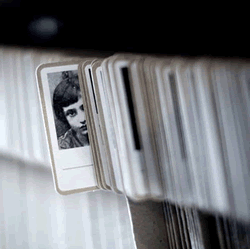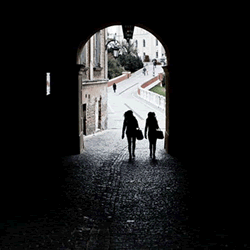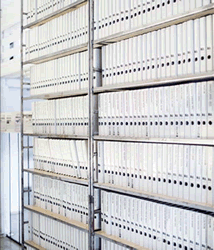The Lost Faces of Lublin
The Polish city’s Jews were wiped out in the second world war. One man is determined to tell their stories
FT Magazine Nov 20, 201

Some of the many files documenting the lives of Jews who perished in the second world war, compiled at the Grodzka Gate Theatre in Lublin, Poland
©Rafal Milach

Locals walk through the 16th-century Grodzka Gate, once the passage between the Jewish and Christian areas of the city
©Rafal Milach
Tomasz Pietrasiewicz, the driving force behind the Grodzka Gate project
©Rafal Milach
A room at the centre where a young Jewish girl hid during the war. The chalk outlines show where her furniture stood
©Rafal Milach

Files containing the stories of those who risked their lives to save Jewish people
©Rafal MilIn a city that for decades had buried its Jewish past, this grainy black-and-white image has helped to prise open the lid on a history that many in Poland are only just coming to terms with. “Henio was born in 1933. His father took a photograph of him every year,” says Tomasz Pietrasiewicz, the man who discovered Henio’s story and who has dedicated the past 20 years to chronicling the lives of Lublin’s murdered Jews. He flicks through the seven photographs showing the smiling boy getting older. “And that is the last picture: 1939.”The young boy has a shy smile and neatly combed hair, and his smart-collared shirt is tightly tucked into a pair of flannel shorts pulled up high on his waist. In his striped socks and bright white shoes, this is the last photograph of Henio Zytomirski, a six-year-old Jewish boy. He would be murdered three years later in a gas chamber in the Majdanek extermination camp on the outskirts of the city of Lublin, in Nazi-occupied eastern PoHenio has become the personification of the Holocaust in this eastern Polish city. More than 40,000 Jews were killed here but for decades that horror was erased from history, buried by repression and forcibly forgotten by a generation of postwar Poles desperate to ignore what they had witnessed. “The places are gone and the people are gone,” says Pietrasiewicz. “But here, Henio is still alive.”
We are standing in the Grodzka Gate NN Theatre, part museum, part library and part cultural institute, where Pietrasiewicz, its founder, has painstakingly pieced together the lives of thousands of forgotten people, a mission sparked by the boy with the shy smile who never saw his 10th birthday.
The Grodzka Gate, in which the institute is housed, was built in 1342. For centuries it marked the division between Christian and Jewish Lublin.
To stand under its arch and look out, away from the medieval city walls, is to gaze across an expanse that 75 years ago was one of Poland’s most vibrant Jewish communities. In 1939, 43,000 of Lublin’s 122,000-strong population were Jews. Many of them lived in a bustling network of small streets around and between the gate and a 12th-century castle. Today, nothing but the gate and the castle remain.
A vast car park, flanked on one side by town houses, dominates the view. A small park hugs the base of the castle’s mound. A pizza takeaway, ice-cream shop and taxi rank have replaced a Jewish district whose population was systematically eradicated, before the buildings were razed one by one.
Such was the hurry with which postwar communist authorities smothered this dark history — less than a decade after the last Jews were killed in concentration camps — that the foundations of the destroyed homes can still be found, buried under the tarmac. “There were houses, shops, printing houses, synagogues. Everywhere you could hear Yiddish,” says Pietrasiewicz. “You have a concrete space here. If you lift it up, you would see the foundations of the houses. But despite this concrete shell, the memories come through.”
The city’s main dual carriageway cuts across the land to the north of the castle, slicing through an area that was once one of the most important Jewish settlements in the world, the location of Europe’s most senior rabbinical school. Every morning, thousands of the city’s commuters driveover the remains of a synagogue built in 1567 and big enough to accommodate more than 3,000 people. Used by the Nazis to sort Jews selected for deportation to death camps, it was burnt to the ground afterwards; all that remains of it today is a plaque. “Walking here, every day, we walk over destroyed streets,” says Pietrasiewicz. “We are walking on the burning foundations of houses. It is not a closed history. It is warm. This is not the history of the Battle of Waterloo but of people still crying, still hurting.” He stares out over the bleak car park. “This is not only the disclosure of a forgotten town but it is a reaction to something that is still a moral issue, saving the memory of what happened here.”
. . .
In many ways, Lublin was the heart of the Holocaust in Poland. Of the city’s 43,000 Jews, fewer than 300 survived there. Operation Reinhard, the Nazi programme to systematically murder all of occupied Poland’s two million Jews, was headquartered here. The plans for Belzec, the first extermination camp, were drawn up and its construction administered in Lublin: Belzec and the Sobibor and Treblinka death camps are all less than 200km away. The Majdanek camp is just outside the city. At least two million people died in these four locations between October 1941 and November 1943, and thousands more were shot in the forests around them.
“The logistical operation of the death camps was run here. The organisational geniuses were here, the people that came up with industrial killing,” says Pietrasiewicz. “The main warehouses of the Reinhard action, with millions of shoes, clothes jewellery and gold, were all here in Lublin.”
Sixty years old, with bright eyes and a sharp wit, Pietrasiewicz works alone every night in the institute from 1am until 7am on his own projects, after which he starts his day job as operations manager. He sleeps from 7pm until midnight.
He was born in Siedlce, a town two hours’ drive north, and moved to Lublin as an infant, later studying in the city. He joined the anti-communist underground movement, working as an editor and printer for samizdat publications while developing a passion for theatre. That led him to the Grodzka Gate in 1992, where he had dreams of forming a theatre company in the building. Not Jewish himself, it was when he stumbled on the history of the gate, and of Lublin itself, that he had an epiphany.
“It changed my life,” he says. “Imagine living here, with no idea of what had happened. Nobody ever told me. And then I was hit with this information. Every person has turning points in their life, and I had that moment — whether to create a theatrical institution without any regard for what had happened here before, or to do something about it.”
“He collected stories, fragments of memory, diary entries, letters. And a picture began to form of a community expunged from history
”
His problem was that much of the documentary evidence of Lublin’s murdered Jews had been destroyed along with their homes. In the late 1960s, Poland’s communist regime launched a virulent anti-Semitic campaign, driving out many of the Jews who had managed to survive the Holocaust and instilling prejudice among the state apparatus.
There were no archives or files in Lublin’s library or history museum — traditional research methods were useless. Instead, Pietrasiewicz began to talk to people. He collected stories, fragments of memory teased from witnesses, photographs from private collections, letters and diary entries. Slowly a picture began to form of a community expunged from history.
. . .
From those first memories, Pietrasiewicz’s mission has become all-consuming. The Gate has become one of Poland’s most important archives of Jewish history. Since it opened, 1,600 people have come forward to tell their stories or donate books, diaries or photographs. Dozens work on chronicling the history, processing documents, oral transcripts and photographs.
Marian Turski, vice-president of the Association of the Jewish Historical Institute in Poland, credits Pietrasiewicz with building a bridge between an often wide gap separating Christian and Jewish Poland. “Grodzka Gate, which before the war was the link between the two Christian and Jewish cultures, symbolically regained its former function thanks to the work of Tomasz Pietrasiewicz. It is a place where the memory of a common Polish-Jewish past of the city is continually cultivated.”
Five years ago, a project was begun to create a file for every one of the 1,500 homes that existed in Jewish Lublin before the second world war. Today at least 900 of them are filled with letters, photographs and official documents, each painstakingly compiled by researchers often working with just a name or a fragment from a diary to give them a clue of who lived there. Relatives come with just the memory of a street name, or a number, and find out for the first time about the lives of their family members. “We are creating an ark of memory, to take into the future,” says Pietrasiewicz.
The next stage of the archive is even more daunting. Pietrasiewicz and his team are creating a file for each of the pre-Holocaust city’s 43,000 Jewish residents. Throughout the centre, everywhere you look there are metal shelves packed with pale green files, or empty ones waiting to be filled. They snake through the exhibition rooms like a thread that ties everything together. It is a powerful sight: impressive for its sheer scale, eerie and unsettling. Many of the files contain just a blurred photograph of an anonymous face, some just a name. “It is a massive process of finding materials,” Pietrasiewicz explains. “We can take just a single sentence out of a story, a speck of memory. For us it is NN — ‘No Name’: it might be the only trace of that person’s existence and nothing more will be found. This project shows us the tragedy of how little we know about some people, and how we will never know anything of others,” he says. “Most of them will be empty, no-name files, waiting, maybe, to be filled.”
A medieval building, the centre is cramped and labyrinthine. Its stone walls and floors are cold, its ceilings very low in parts. Its shape lends itself to the sense of discovery and revelation that Pietrasiewicz was sure almost all its local visitors would feel. We are led through the exact room where a young Jewish girl was hidden during the Nazi occupation, the outlines of her furniture painted in white on its grey floor, like the chalk outline of a corpse at a crime scene. Her story ends more brightly: decades later she came to Pietrasiewicz and recorded her memories, one of hundreds whose voices fill 5,000 hours of recordings at the centre.
Behind a moveable panel, a 20ft black-and-white photograph of the Jewish district before its destruction covers an entire wall. Only the castle and the gate are recognisable from the scene outside the window. The contrast is startling.
Upstairs is a darker set of rooms, accessed through an eviscerated wooden door frame recovered from the ghetto where, poignantly, the mezuzah used to signify a Jewish house has been removed. In the first room, in almost pitch darkness except for the light from a computer tablet bearing the last recorded list of Lublin ghetto inhabitants, thousands of names are read out continuously in alphabetical order.
Next, a dark, foreboding space is filled with tree trunks, conveying the legend of how Jews came to Poland, finding a forest outside Lublin with trees marked with the word “Polin”, Hebrew for “you should stay here”. Polin became the Hebrew word for Poland.
In the attic of the museum, you are plunged back into light. Here are the stories of the “righteous among the nations” — those who risked their lives to save Jews during the Holocaust.
“I didn’t want to have an exhibition per se. I wanted to create an artistic installation,” Pietrasiewicz says. “It is a scene without actors.”
Indeed, he has not fully abandoned his passion for theatre. Conscious of the need to speak to people who perhaps would not choose to visit Grodzka Gate, he takes history out on to the streets. Every year on March 16, he arranges for the lights on what was the Jewish side of the gate to be extinguished to mark the day in 1942 when the Lublin ghetto was burnt to the ground. One night in October 2002, he opened 100 manhole covers in the car park and lowered electric lamps and speakers inside them, sending columns of light and the sounds of recorded testimonies from Jewish Lublin up into the night. In the public park in the Gate’s shadow, he has erected a street lamp that was rescued from the rubble. Switched on a decade ago, it is lit 24 hours a day — “to remind people of what happened here”.
Such a mission is not without controversy. For while the institute is a monument to a forgotten people, it is also testament to an attempt to suppress history, an uncomfortable chronicle of a city that actively ignored its past in a country that has yet to come to terms fully with what happened between 1939 and 1945.
Pietrasiewicz’s campaign is an important step in combating a rise in discrimination against minorities in Europe, says Amnesty International’s Marco Perolini. “Although he is not Jewish, he has been targeted for years with anti-Semitic speech, violence and a public discriminatory campaign because of his engagement as an artist and human rights defender,” says Perolini. “Tomasz’s commitment is crucial to counteract stereotypes, discrimination and more generally to avoid historical oblivion, even more so in a context in which several elements point to a possible rise of discrimination and violence, in Poland and elsewhere in Europe.”
Lublin today is a city of 350,000, the largest in Poland east of the Vistula river, a physical line that in a crude sense divides the richer, more developed and liberal west from the relatively deprived and conservative east. Its quaint old town and medieval castle draw a healthy smattering of tourists, while a handful of local universities have fuelled a successful IT industry.
The second world war reshaped Poland probably more than any other country. It emerged after the destruction with its borders shifted and its people forcibly relocated. Reborn as an almost wholly Catholic nation, stripped of the religious and ethnic diversity that had characterised it for centuries, it was populated by people who were keen to forget and move on.
“Anti-Semiticattitudes have been in decline in Poland but discrimination lingers. ‘We have not solved it. But I can see progress’
”
Over the past decade, anti-Semitic attitudes have generally been in decline in Poland (though surveys have shown blips), as the vibrant young democracy embraces global ideas and liberalism percolates through its society, particularly its strongly European youth. Institutes such as Grodzka Gate and the recently opened Polin Museum of the History of the Polish Jews in Warsaw have alerted huge numbers of Poles to the contribution that Jews made to Poland’s rich history. But discrimination lingers. “Poland has a problem with anti-Semitic attitudes. There is no hiding it,” says Pietrasiewicz. “We have not solved it. But I can see progress from my point of view, and that is already a lot.”
Part of the resistance to Pietrasiewicz’s project was professional, with opposition from local politicians and pressure groups, and some of it was frighteningly personal. Stones painted with swastikas were thrown at his windows. A bomb squad was called to dismantle an explosive device left outside his house, and for years posters were plastered around the city bearing his face, with Jewish symbols and anti-Semitic threats. “I was attacked for being a friend of the Jews,” he says calmly. “It surprised me that what I did awoke so many negative emotions. I knew that there must be people that opposed this but I never thought it would result in aggression.”
Pietrasiewicz rejects the notion that he is a hero or celebrity. While his supporters clearly idolise him and his vision, he is uncomfortable talking about himself, steering the conversation back to the project. Last month he received the inaugural award created by the Polin museum to honour those who work to protect the memory of Polish Jews. At a moment when eastern Europe struggles once again with the idea of multi-ethnic societies, his work in Lublin seems especially timely and relevant.
“Sometimes I asked myself, ‘How important is this? What am I doing?’ And I realised that what the Nazis wanted to do here was not only kill the Jews but erase any trace of them afterwards. If there is evil in this world, it is from this dark utopian idea,” he says. “So what I am doing is creating another utopia. Looking for names. Looking for stories. The forces of darkness and the forces of light, in one place, one archive, hoping that more will be found.”
He looks at the racks of empty files that fill the room and pauses. “It will never be finished.”
Grodzka Gate NN Theatre, Grodzka 21, Lublin (teatrnn.pl)
Henry Foy is the FT’s central Europe correspondent
Photographs: Rafal Milach |